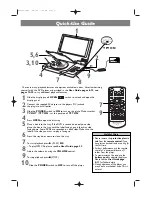
24
5.6 FIELD OPERATION
Although the Portable Generator is easy to use, each
operator should review this section to familiarize
himself with the detailed safety and operating
procedures. When using this machine, follow this
procedure:
1. Clear the area of bystanders, especially small
children.
2. Review and follow the Pre-Operation Checklist
(see Section 5.4).
OPERATING SAFETy
• Read and understand operator's manual before
starting. Review safety instructions annually.
• Stop and disable engine, remove ignition key
and place in your pocket and wait for all mov-
ing parts to stop before servicing, adjusting or
repairing.
• To prevent electrical shocks, do not operate
this generator in the rain or with wet hands. It
should be grounded in damp or highly conduc-
tive conditions.
• Close and secure all guards, deflectors and
shields before starting and operating.
• Do not connect the generator to a commercial
power line.
• Do not operate with damaged or defective
extension cords, or power cords. Never oper-
ate any electrical equipment with damaged or
defective cords.
• Do not operate this generator in areas with poor
ventilation. The exhaust fumes contain carbon
monoxide, a poisonous, odorless, invisible gas.
Prolonged exposure can lead to unconscious-
ness and death.
• Do not refuel the engine while it is in operation
or still hot. Do not refuel the engine near open
flames, pilot lights or sparking electrical devices
(e.g. power tools, welders or grinders). Do not
operate the generator near flammable products.
• The engine should be refuelled in a well-lit area.
Avoid fuel spillage.
• Never allow children or unauthorized people
to operate or be around this machine.
• Keep the working area clean and free of de-
bris to prevent tripping. Operate only on level
ground.
• Do not cover the generator while in operation.
Overheating can result in damaged equipment.
• For storage, do not cover the generator until it
has cooled down completely.
• The ambient temperature should not exceed
100° F/40° C.
3. Position the generator in the following manner:
a. Level to minimize the chance of spilling fuel.
b. In a dry area to prevent shocks and shorts.
c. Away from all flammable liquids and fumes.
d. With a ground to minimize the chance of
shocks and shorts.













































